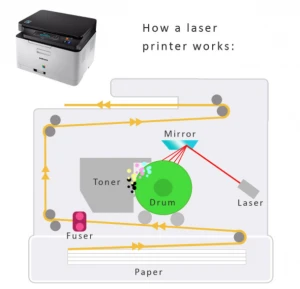by Malcolm Woods
Every office or workplace nowadays needs a printer and when it comes to choosing between inkjet and laser printers, most of the workplaces opt for a laser printer and we will tell you why and How do Laser Printers work ? The laser printer is more cost-effective because the per-page printing cost is lower and also they are cheaper to operate. Laser printers are preferred in offices because they provide a considerably better result for printing documents than an inkjet printer.
It is easy to decipher how an inkjet printer works as the name suggests that it uses droplets of ink to print the document. The name in itself is very descriptive whereas in the case of a laser printer it is very mysterious as to how a laser or a beam of light would write on a piece of paper from a document on your computer. Sounds impossible right? Because you can't write from a beam of light yourself. But that's how a laser printer works. The mystery of how do laser printers work will be sorted towards the end of the article.
Dot-matrix printers were used until the early 1980s which were not only slow but made a screeching noise whilst printing. To be precise these took about a minute to print a page whereas laser printers barely take a few seconds to print. Not only were they slow but the quality of the output was not up to mark. But as the use of computers grew especially when people started getting their personal computer that was when a faster printer was demanded.
The laser printer was first introduced in the year 1960 by Gary Starkweather of Xerox who took ideas from a photocopying machine. But officially a commercial laser printer was launched in the mid-1970s that could capably print 60 pages in a minute which was quite impressive. But it cost a fortune. For making affordable laser printer companies like HP and Canon stepped in and made cheaper yet bigger laser printers. We would credit HP and Apple for bringing laser printers to the market and mass producing them so that they were affordable for everyone, although the technology credit still goes to Xerox.
To put in the simplest words to make you understand how laser printers work, they are more like photocopiers and uses almost the same generic technology. It won't be wrong to say that the first laser printer was a merely upgraded version of a photocopier. Photocopier machine copies an already printed page by using a sharp bright beam of light. Light is reflected off the page on a drum which is light sensitive and the static electricity works to stick the ink particles to the drum. With the help of hot rollers, the ink is then transferred to paper and then fused on its surface. The only difference is for a laser printer the writing process starts from scratch since there is no existing paper to copy from.
Laser printers use an electrostatic digital printing process which is used to print high-quality graphics which is a result of the passing of light beams repeatedly. Still a mystery for you as to how the laser printer works? We will provide an easy to understand step by step guide to help you comprehend how it actually works. As you give the print command to your computer, the information contained in the document that you want to print is sent to the printer and is stored in the memory of the printer.

The process starts by using a heated wire to charge the drum positively which when passed changes the charge by reversing it to the areas where it hits. All the negatively charged areas of the drum basically represent the text that is to be printed. This is followed by a toner roller passing over the drum that is used to stick particles to the area that is negatively charged. Under the drum on which toner particles stick to it, there are sheets of paper placed over which the toner is passed which makes the printed copy of the document that you had in your computer.
Following are the steps of how to do laser printers work.

In order to better understand how do laser printers work, it is essential to understand each component of the printer. Laser printers are composed of 8 major components and each plays a vital role in getting a high-quality print. We will now be discussing the anatomy of a laser printer in detail so you further get an idea of how a laser printer works.
Power supply plays an important role in converting AC current into high voltages which are required to charge the drum so that the transfer process can begin. For a laser printer higher voltage is required to charge the drum.
This component holds the most important because this drum unit attracts positively charged toner particles onto the surface. This process is done through the corona wire which is capable of carrying high voltage. As soon as the drum is charged as per the requirement, with the help of mirrors, a laser beam is guided to the surface that is used to scan the text on the surface of the drum.
Toner cartridges house carbon or iron oxide powder or microscopic ink particles also known as the toner. This toner is positively charged, which when heated melts that fuses to paper. These toner cartridges have to be replaced when they are emptied. CMYK colors are used which can produce any color when they are joined.
This wire also has a vital part in the printing process because this wire is responsible for charging the drum unit positively so that toner particles can be drawn onto the surface. Specifically, the transfer corona wire has a negative charge so that the toner particles can be drawn onto the sheet from the drum. Since both these wires require high voltage, as mentioned earlier, in order to create sufficient charge henceforth the power supply is used to fulfill this requirement.
As the name of the printer suggests this part holds special importance because it transmits the beam from the diode through a series of mirrors which is used to reflect the beam on the drum unit as soon the laser is active. This then imprints the text on to the drum by reflecting the laser.
This belt is used for the movement of paper in the printer and henceforth passes through the drum in order to get the toner transferred on the sheet. This is exactly like a roller, but rollers are used in comparatively smaller laser printers whereas, in larger laser printers, a transfer belt is used for this purpose.
This unit has two rollers that are heated in order to get the toner particles fused on the sheet of paper. As the sheet passes through toner particles are melted by the heated rollers. This process is done to convert the powder form to a more sealed form in order to prevent any smudges and are perfectly printed. This is done by a high level of both pressure and heat which results in toner building a strong bond with the paper. Even though this operates at a high level of heat but there are no chances of any fire owing to the fact that the operation is carried in a rather quick fashion.
All the unused excess toner from the printing process is collected in this waste toner bottle from the photosensitive drum. As soon as the bottle reaches its maximum capacity, it requires replacement.

Since you now know how to do laser printers work and have understood the anatomy of a laser printer we will now move to the benefits that this unit provides. There are several factors because of which laser printers are preferred by the offices and workplaces where frequently printers are used for printing documents. These are ideal for printing loads of documents and by this, we mean tens of thousands of pages because the toner cartridge of a laser printer has the capability to do so.
One of the most basic edges that these laser printers get is that they are relatively much faster and are capable of printing a much higher number of pages per minute than other printers, especially inkjet printers. This feature makes it the top choice for offices because in such workplaces there are thousands of pages printed on a daily basis so it is essential to have a printer that offers a good enough speed that does not halt other operations. Laser printers are best suited for high volume printing requirements.
Since these are ideal for high volume printing henceforth it is essential that you incur lesser running costs. So there is good news for you that the toner cartridges that these laser printers use are much cheaper than the ink cartridges used in its direct competitor inkjet printers. Although the initial investment in a laser printer is more than that of an inkjet printer later they prove to be far more competent and cost-efficient.
The Toner cartridge of a laser printer allows uninterrupted printing of thousands of pages before you need to replace one. They have high capacity and are highly capable and efficient to provide the best quality and quantity of pages printed. Since they are aimed to provide an effective high volume printer therefore they are designed by having the reliability factor in mind. This is why they are made of stronger and durable material that makes them last longer which is why they prove to be perfect in workplaces with heavy printing.
Because of high volume printing capabilities, these laser printers do not compromise on the quality. These laser printers undoubtedly provide the finest and most accurate results because of the microscopic properties of the toner. As the level of precision increases so does the level of the quality and resolution of printing. Since these printers have an overall lesser cost attached to them and are capable of high-quality output that is why it is a far more demanded and preferred choice nowadays.
 |
 |
 |
 |

About Malcolm Woods
Malcolm Woods is a blogger who enjoys writing about technology and solar power. He has a passion for learning new things, and loves to share his knowledge with others. Malcolm is also an advocate for sustainable living, and believes that everyone has a responsibility to do their part in preserving our planet.
 |
 |
 |
 |
Check These Out
Go for the FREE Gifts. Or check out for free energy books from our best collection.
Remove Ad block to reveal all the secrets. Once done, hit a button below
 |
 |
 |
 |